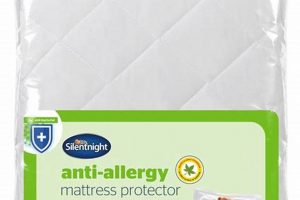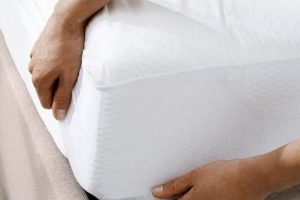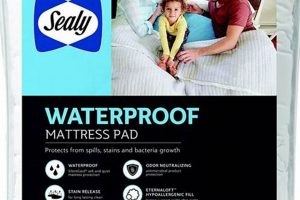Guidance for laundering a mattress covering is essential for maintaining hygiene and prolonging the life of the bedding accessory. These directives generally outline the appropriate water temperature, detergent type, and drying method to ensure the material remains effective in protecting the mattress from spills, stains, and allergens. For example, a care label might specify washing in cold water with a mild detergent and tumble drying on a low heat setting.
Following the recommended cleaning procedures is crucial because it preserves the protective qualities of the cover. Proper maintenance helps prevent the buildup of dust mites, bacteria, and other allergens, which can improve sleep quality and overall health. Furthermore, adherence to these guidelines prevents shrinkage, damage to the waterproof membrane (if present), and degradation of the fabric, thus extending the lifespan of the mattress protector and reducing the need for frequent replacements.
The subsequent sections will detail specific recommendations for various types of mattress coverings, covering pre-wash preparations, suitable washing machine settings, appropriate drying techniques, and solutions for stain removal and odor elimination to ensure a thorough and effective cleaning process.
Key Considerations for Mattress Protector Laundering
Optimizing the cleaning process for mattress coverings requires careful attention to detail. The following recommendations aim to ensure effective sanitization and longevity of the protective layer.
Tip 1: Pre-Treat Stains Promptly: Address any visible stains, such as spills or bodily fluids, with a stain remover before washing. Pre-treating prevents stains from setting during the wash cycle and potentially compromising the fabric.
Tip 2: Consult the Care Label: Always review the manufacturers care label for specific directives regarding water temperature, detergent type, and drying methods. Deviating from these instructions could damage the protective layer or cause shrinkage.
Tip 3: Utilize Cold or Warm Water: Washing in cold or warm water helps preserve the fabric’s integrity and prevents fading. Hot water can degrade certain materials, particularly those with waterproof backings.
Tip 4: Employ a Mild Detergent: Harsh chemicals can damage the fibers and reduce the effectiveness of the protective layer. Opt for a gentle, hypoallergenic detergent to maintain its quality.
Tip 5: Tumble Dry on Low Heat: High heat can cause shrinkage or warping of the mattress covering. Tumble drying on a low heat setting or air-drying is recommended to preserve its shape and functionality.
Tip 6: Avoid Bleach and Fabric Softeners: Bleach can weaken the fabric and compromise its protective properties. Fabric softeners can leave a residue that reduces the breathability of the material. Refrain from using these products during the wash cycle.
Tip 7: Ensure Thorough Drying: Before replacing the cover on the mattress, confirm that it is completely dry. Dampness can promote the growth of mold and mildew, undermining the hygiene of the sleeping environment.
Following these guidelines contributes to maintaining a clean and healthy sleep environment while extending the lifespan of the mattress protector, ultimately optimizing its protective benefits.
The next section will discuss the consequences of ignoring laundry guidelines and how it impacts health and hygiene.
1. Water Temperature
Water temperature is a critical element within mattress protector laundering protocols. The selected water temperature directly influences the integrity and longevity of the protective fabric. Elevated temperatures can cause shrinkage, particularly in protectors incorporating cotton or synthetic blends. Moreover, heat can degrade the waterproof membrane commonly found in these items, diminishing their ability to prevent liquid penetration. In contrast, excessively low temperatures might not effectively remove accumulated body oils, dust mites, and allergens, thereby compromising the hygiene of the bedding.
Manufacturers typically specify a recommended water temperature range on the care label. Deviation from these instructions can lead to premature failure of the protector. For instance, washing a protector labeled for cold water in hot water could result in a warped or shrunken product, rendering it ineffective. Conversely, neglecting to utilize warm water for a heavily soiled protector could leave behind residual stains and allergens, necessitating more frequent laundering or eventual replacement. Proper temperature management during the washing process is, therefore, essential for optimizing both cleanliness and durability.
In summary, adhering to the manufacturer’s guidance regarding water temperature during mattress protector washing is not merely a suggestion but a crucial factor in maintaining the protector’s performance and extending its lifespan. Improper temperature selection can lead to irreversible damage and compromise the protector’s intended function of safeguarding the mattress. Thus, careful attention to this detail is integral to responsible bedding maintenance.
2. Detergent Type
The selection of detergent significantly impacts the outcome of mattress protector washing. Harsh detergents, containing bleach or strong enzymes, can degrade the fabric fibers, compromise waterproof layers, and diminish the overall protective qualities of the mattress covering. Conversely, ineffective detergents might fail to adequately remove allergens, oils, and stains, leading to a buildup that compromises hygiene and potentially shortens the product’s lifespan.
For instance, using a standard laundry detergent with optical brighteners on a dark-colored mattress protector may cause discoloration or fading. Similarly, applying a concentrated detergent without proper dilution could leave a residue that irritates sensitive skin or attracts more dust mites. Conversely, employing a detergent specifically formulated for delicate fabrics ensures a gentle yet thorough cleaning, preserving the material’s integrity and extending its usability. Certain mattress protectors may have specialized coatings or laminates; these often require a pH-neutral detergent to prevent delamination or damage to the coating.
The correlation between detergent type and mattress protector washing instructions hinges on maintaining both cleanliness and fabric integrity. Prioritizing mild, hypoallergenic detergents devoid of harsh chemicals aligns with responsible bedding maintenance, promoting a healthy sleep environment and maximizing the mattress protector’s protective capabilities. Failure to select the appropriate detergent results in compromised hygiene, reduced product lifespan, and potential discomfort for the user. The adherence to specific detergent recommendations listed on the care label is thus essential for optimal cleaning and preservation of the mattress protector.
3. Drying Method
The procedure employed for drying a mattress protector following laundering directly influences its integrity and long-term functionality. Selecting an inappropriate drying method can negate the benefits of proper washing, leading to damage, shrinkage, or a reduction in its protective capabilities. Therefore, adherence to specified drying directives is paramount within a comprehensive mattress protector washing regime.
- Tumble Drying Temperature
Tumble drying, if permitted, necessitates careful attention to temperature settings. High heat can compromise the waterproof membrane present in many mattress protectors, causing it to delaminate or crack, thereby rendering the protector ineffective against spills. Furthermore, excessive heat can lead to shrinkage, altering the protector’s fit and rendering it unusable. Adhering to a low heat or no-heat setting, as indicated on the care label, mitigates these risks and preserves the protector’s structural and functional integrity.
- Air Drying Techniques
Air drying presents a gentler alternative to machine drying, minimizing the risk of heat-related damage. Effective air drying involves suspending the protector in a well-ventilated area, away from direct sunlight, which can fade or degrade the fabric. Ensuring complete dryness before replacing the protector on the mattress is crucial to prevent the growth of mold and mildew, thereby maintaining a hygienic sleep environment. Improper air drying, such as leaving the protector damp for extended periods, can negate the benefits of washing.
- Material-Specific Considerations
The drying method should align with the mattress protector’s material composition. Protectors constructed from natural fibers, such as cotton, may tolerate low-heat tumble drying. However, those incorporating synthetic materials or waterproof layers often require air drying to prevent damage. Consulting the care label for material-specific drying recommendations is essential for optimizing the drying process and preserving the protector’s unique characteristics.
- Consequences of Improper Drying
Deviation from recommended drying protocols can have adverse consequences. Overdrying can lead to brittleness and cracking of waterproof layers, while insufficient drying can promote microbial growth. Both scenarios compromise the protector’s ability to safeguard the mattress and maintain a healthy sleep environment. Recognizing and mitigating these potential issues through proper drying practices is vital for maximizing the investment in a mattress protector and ensuring its long-term effectiveness.
In summary, the chosen drying method represents a critical phase in the overall process for cleaning mattress protectors, as it directly impacts the material’s structural integrity and protective functions. Adherence to drying guidelines detailed in the “mattress protector washing instructions” is essential to promote product durability, uphold hygiene standards, and protect the warranty of the product, thereby reinforcing the benefits of maintaining a clean and well-cared-for sleeping environment.
4. Stain Removal
Effective stain removal constitutes a critical element within the comprehensive framework of mattress protector washing instructions. Addressing stains promptly and appropriately not only maintains the aesthetic appeal of the protector but also preserves its functional integrity and hygienic properties, necessitating a nuanced understanding of stain-specific treatments and their integration within the overall cleaning process.
- Prompt Action and Stain Identification
Immediate attention to stains is paramount to prevent them from setting into the fabric, thereby simplifying the removal process. Accurate identification of the stain type (e.g., blood, urine, food spills) is crucial, as different stains necessitate distinct cleaning agents and techniques. For instance, enzymatic cleaners are often effective for organic stains, while specific solvents may be required for grease-based marks. Failing to identify the stain correctly can lead to ineffective treatment or even permanent damage to the protector fabric.
- Pre-Treatment Methods
Before subjecting the mattress protector to a full wash cycle, pre-treating the stained area is often advisable. This may involve applying a stain remover directly to the affected area, gently blotting (rather than rubbing) to avoid spreading the stain, and allowing the solution to dwell for a specified period before laundering. Common pre-treatment agents include diluted vinegar solutions for odor neutralization and mild detergents for general stain lifting. Proper pre-treatment significantly enhances the likelihood of complete stain removal during the subsequent wash cycle.
- Compatibility with Washing Instructions
Stain removal methods must be compatible with the manufacturer’s washing instructions for the mattress protector. Harsh chemicals or aggressive scrubbing can compromise the fabric’s integrity, especially in protectors with waterproof or laminated layers. Therefore, selecting stain removers that align with the recommended washing temperature and detergent type is crucial. Always test the chosen stain remover on an inconspicuous area of the protector to assess its impact on the fabric’s color and texture before applying it to the visible stain.
- Post-Wash Inspection and Remediation
Following the wash cycle, a thorough inspection of the treated area is necessary to confirm complete stain removal. If the stain persists, repeating the pre-treatment and washing process may be required, or alternative stain removal techniques may be explored. Avoid placing the protector in a dryer if the stain remains, as the heat can permanently set the stain, rendering it irremovable. Continued efforts to remove the stain before drying are crucial for maintaining the protector’s appearance and functionality.
In summary, stain removal is an intrinsic part of comprehensive mattress protector maintenance, inextricably linked to the protector’s washing instructions. A combination of prompt action, accurate stain identification, compatible pre-treatment methods, and diligent post-wash inspection ensures the longevity, hygiene, and aesthetic appeal of the mattress protector, thereby fulfilling its role in safeguarding the mattress and promoting a healthy sleep environment. Proper integration of effective stain removal techniques within the standard washing routine underscores the importance of adhering to a holistic care approach.
5. Frequency
The regularity with which a mattress protector undergoes laundering represents a crucial determinant in maintaining both its hygiene and its continued functionality. Establishing an appropriate washing frequency, aligned with specific usage patterns and environmental factors, directly impacts the efficacy of the mattress protector in safeguarding the underlying mattress and promoting a healthy sleep environment. Therefore, the interval between washes is an integral component of comprehensive mattress protector washing instructions.
- Usage Intensity and Soil Accumulation
The intensity of mattress protector use significantly influences the optimal washing frequency. Protectors subjected to daily use, particularly in environments with pets or children, accumulate soil, body oils, and allergens more rapidly. In such cases, more frequent laundering, perhaps on a monthly basis, is warranted. Conversely, protectors used in guest bedrooms or less frequently occupied spaces may require washing only every two to three months. Monitoring the protector for visible soiling or odors can provide valuable cues for adjusting the washing schedule accordingly.
- Allergy and Sensitivity Considerations
Individuals with allergies or sensitivities to dust mites, pet dander, or other common allergens benefit from more frequent mattress protector washing. Regular laundering, ideally every two weeks, minimizes allergen accumulation within the bedding, thereby reducing the potential for allergic reactions and promoting improved sleep quality. Using hypoallergenic detergents in conjunction with frequent washing further enhances the allergen-reducing effects. The precise washing frequency should be tailored to the individual’s specific sensitivities and the severity of their allergic symptoms.
- Environmental Factors and Climate
Environmental conditions, such as humidity and dust levels, can impact the recommended washing frequency for mattress protectors. Humid environments promote the growth of mold and mildew, necessitating more frequent laundering to prevent microbial contamination. Similarly, in dusty environments, airborne particles can accumulate within the protector fabric, requiring periodic washing to maintain its cleanliness and hygiene. Adjusting the washing schedule to account for these environmental factors helps preserve the protector’s integrity and promote a healthier sleep environment.
- Protector Material and Construction
The material composition and construction of the mattress protector can influence the recommended washing frequency. Protectors made from breathable fabrics, such as cotton or bamboo, may require more frequent washing to maintain their moisture-wicking properties and prevent the buildup of body oils. Conversely, protectors with waterproof membranes or specialized coatings may necessitate less frequent washing to avoid premature wear and tear. Consulting the manufacturer’s care instructions for material-specific washing recommendations is essential for optimizing the washing schedule and preserving the protector’s unique characteristics.
In conclusion, the determination of an appropriate washing frequency for mattress protectors necessitates a holistic consideration of usage patterns, individual sensitivities, environmental factors, and material-specific properties. The integration of these variables within a comprehensive “mattress protector washing instructions” framework enables users to establish a washing schedule that effectively maintains hygiene, preserves product integrity, and promotes a healthy sleep environment. Deviations from a well-considered washing frequency, whether through neglect or excessive laundering, can compromise the protector’s effectiveness and shorten its lifespan, underscoring the importance of adhering to a proactive and informed maintenance routine.
Frequently Asked Questions
This section addresses common inquiries regarding the proper care and maintenance of mattress protectors. The following questions and answers aim to clarify key aspects of laundering procedures, ensuring optimal hygiene and longevity of the product.
Question 1: How often should a mattress protector be washed?
Washing frequency depends on usage and environmental factors. Generally, a mattress protector requires laundering every 1-2 months. However, more frequent washing (every 2 weeks) is advisable for individuals with allergies or in households with pets. Visual inspection for soiling or odors should also inform the washing schedule.
Question 2: What water temperature is appropriate for washing a mattress protector?
The recommended water temperature is typically cold or warm. Hot water can damage the waterproof membrane or cause shrinkage in some protectors. Always consult the care label for specific temperature guidelines.
Question 3: What type of detergent is suitable for cleaning a mattress protector?
A mild, hypoallergenic detergent is recommended. Harsh chemicals, bleach, and fabric softeners should be avoided as they can degrade the fabric and reduce the protector’s effectiveness. Residue from harsh detergents may also irritate sensitive skin.
Question 4: Can a mattress protector be placed in a dryer?
Some mattress protectors can be tumble-dried on a low heat setting. However, air drying is generally preferred to prevent shrinkage or damage to the waterproof layer. Ensure the protector is completely dry before replacing it on the mattress to prevent mold and mildew growth.
Question 5: How should stains be treated on a mattress protector?
Prompt stain treatment is essential. Use a stain remover appropriate for the stain type, applying it directly to the affected area. Gently blot the stain, avoiding rubbing, and allow the remover to dwell before washing. Ensure the stain remover is compatible with the protector fabric to avoid damage.
Question 6: Is it necessary to wash a new mattress protector before using it?
Washing a new mattress protector before initial use is recommended. This removes any residual manufacturing chemicals or dust that may be present on the fabric, ensuring a cleaner and more comfortable sleep environment.
Proper adherence to these laundering guidelines contributes to maintaining a clean, healthy sleep environment and extending the lifespan of the mattress protector.
The subsequent section will provide information regarding warranty implications in the event of improper cleaning.
Conclusion
This exposition has detailed the critical elements of “mattress protector washing instructions”, encompassing water temperature, detergent selection, drying methods, stain removal, and frequency. Adherence to these guidelines is essential for preserving the protective capabilities and extending the lifespan of the mattress covering. Deviation from manufacturer-recommended procedures can compromise the material’s integrity and invalidate warranty provisions.
The diligent application of appropriate laundering techniques, as outlined, represents a proactive investment in both sleep hygiene and the long-term protection of the mattress. Consistent and informed care ensures a cleaner, healthier sleep environment and maximizes the value derived from the mattress protector. Future advancements in textile technology may introduce novel cleaning methods, but the fundamental principles of gentle handling and informed decision-making will remain paramount. Therefore, informed adherence to established best practices is encouraged.


![Best Malouf Mattress Protector [Guide & Review] Organic & Natural Mattress Buyer’s Guide: Non-Toxic Sleep Solutions Best Malouf Mattress Protector [Guide & Review] | Organic & Natural Mattress Buyer’s Guide: Non-Toxic Sleep Solutions](https://mattressworldpa.com/wp-content/uploads/2025/07/th-2531-300x200.jpg)
![Best Purple Protector Mattress: [Benefit] & Protection! Organic & Natural Mattress Buyer’s Guide: Non-Toxic Sleep Solutions Best Purple Protector Mattress: [Benefit] & Protection! | Organic & Natural Mattress Buyer’s Guide: Non-Toxic Sleep Solutions](https://mattressworldpa.com/wp-content/uploads/2025/07/th-2530-300x200.jpg)



